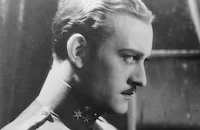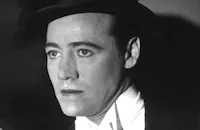Dynamite

Brief Synopsis
Cast & Crew
Cecil B. De Mille
Conrad Nagel
Kay Johnson
Charles Bickford
Julia Faye
Joel Mccrea
Film Details
Technical Specs

Synopsis
Society girl Cynthia Crothers marries Hagon Derk, a miner sentenced to be executed for murder, to fulfill the terms of her grandfather's will. The miner is found innocent at the last minute, dashing Cynthia's hope of marrying her lover, Roger, a man whose wife refuses to divorce him. Advised by her lawyers that she should live with her husband so as to obtain her money, Cynthia goes to the mining town and lives the life of a miner's wife. There she realizes the futility of her former life when a mine disaster threatens to take both Hagon and Roger away from her. After Roger is killed in a dynamite explosion while helping them escape, Cynthia finds happiness with the miner.

Director

Cecil B. De Mille
Cast

Conrad Nagel

Kay Johnson

Charles Bickford
Julia Faye

Joel Mccrea
Muriel Mccormac

Robert Edeson
Henry Stockbridge

Leslie Fenton
Barton Hepburn
Tyler Brooke
Ernest Hilliard
June Nash
Nancy Dover
Neely Edwards
Jerry Zier
Rita Leroy
Clarence Burton
James Farley
Robert T. Haines
Douglas Frazer Scott
Jane Keckley
Fred Walton
Ynez Eabury
Blanche Craig
Mary Gordon
Scott Kolk
Russ Colombo
Crew
Adrian
Anne Bauchens
J. K. Brock
Cecil B. De Mille
Cedric Gibbons
Jack King
John Howard Lawson
Mitchell Leisen
Mitchell Leisen
Jeanie Macpherson
Jeanie Macpherson
Peverell Marley
Dorothy Parker
Douglas Shearer
Herbert Stothart
Gladys Unger

Film Details
Technical Specs

Award Nominations
Best Art Direction
Articles
Dynamite
Dynamite was not only DeMille's first complete talkie, it was also his first movie during his short tenure at MGM. The director, a fixture at Paramount Studios, had tried to become an independent late in the 1920's but did not succeed. MGM took him under its wing although, as one of the most autocratic directors of all time, DeMille chafed under MGM's production line methods.
The plot for his first film for the new studio did not, however, come from the front office. DeMille got the idea himself, sparked by a headline reading MAN MARRIES WOMAN TWO HOURS BEFORE HE IS HANGED FOR MURDER. Working with writer Tyler Brooke, he turned it into a story about an heiress, in love with a married man, who must be married by a certain date or she will lose the trust fund she needs to get her lover a divorce. To get around the terms of the fund, she marries a man on death row expecting to become a wealthy widow. However, before the condemned man can be executed, the real killer is found!
As was typical with Hollywood casting at that time, DeMille turned to Broadway for some of his actors. The hot-tempered star Charles Bickford began his decades-long film career playing the condemned man while Kay Johnson, star of the stage version of A Free Soul (1928) played the heiress. Mitchell Leisen, art director on Dynamite and later director of such classics as Midnight (1939), tried to steer DeMille toward another actress: "Carole Lombard was originally announced for the role Kay Johnson played. DeMille made a test of Carole and decided she wouldn't do, much to my disappointment, since Carole and I were already close friends and this was her big chance."
Another immigrant from the East Coast also played a small role in the making of the film. Algonquin Table wit Dorothy Parker was at MGM working on a script that was never made. At loose ends, she was recruited to write a song for Dynamite since, at that time, no talking picture was complete without a song. Her first effort, "Dynamite Man, I Love You," was rejected as was, according to legend, one called, "Dynamite, Dynamite, Blow My Sweet One Back To Me." Finally Parker concocted "How am I to Know?" which, set to music by Jack King, is sung during a prison house scene.
DeMille crammed enough plot for three movies into Dynamite. A last-minute reprieve, two intersecting love triangles and a spectacular mine cave-in sparked by the titular explosive helped DeMille blow Dynamite to a higher level of excitement than the typical gab-fests of the early talkie era.
Director: Cecil B. DeMille
Screenplay by Jeanie Macpherson with additional dialogue by Macpherson, John Howard Lawson and Gladys Unger
Producer: Cecil B. DeMille
Cinematographer: Peverell Marley
Editor: Anne Bauchens
Art Director: Cedric Gibbons and J. Mitchell Leisen
Cast: Conrad Nagel (Roger Towne), Kay Johnson (Cynthia Crothers), Charles Bickford ('Buddy' Derk), Julia Faye (Marcia Towne), Joel McCrea (Marco), Muriel McCormac (Katie Derk).
BW-127 min.
by Brian Cady

Dynamite
Quotes
Trivia
'Lombard, Carole' was replaced during filming, but can still be seen in the released print.













